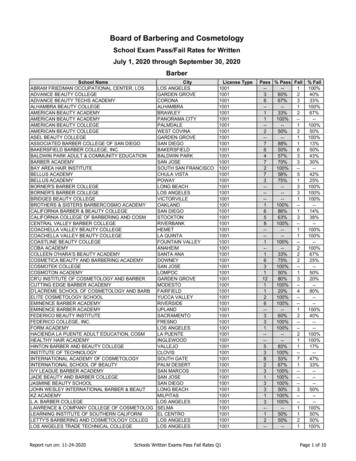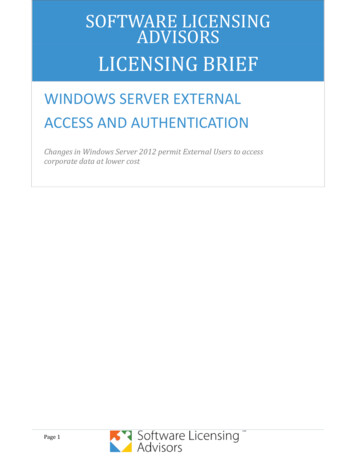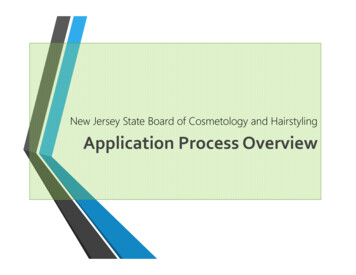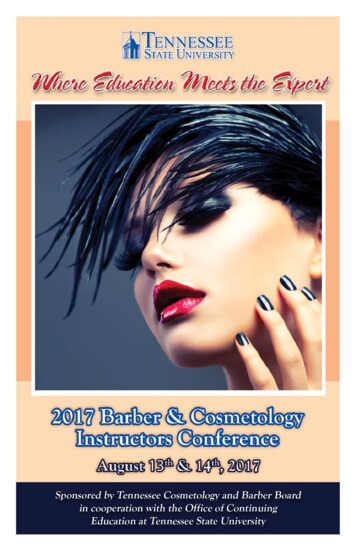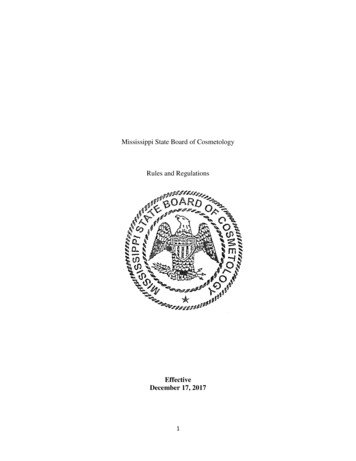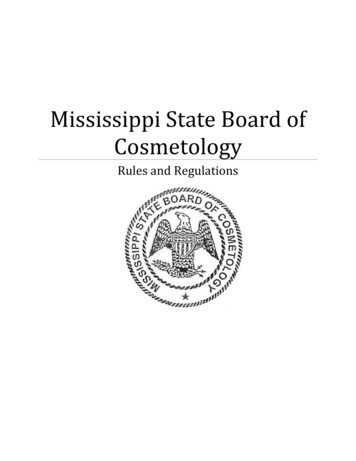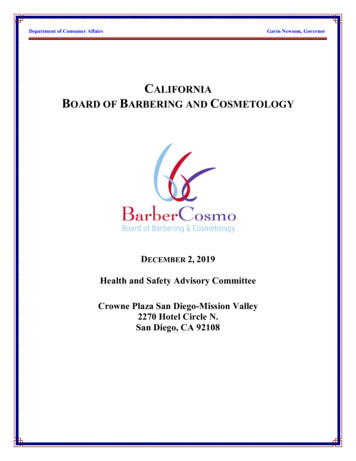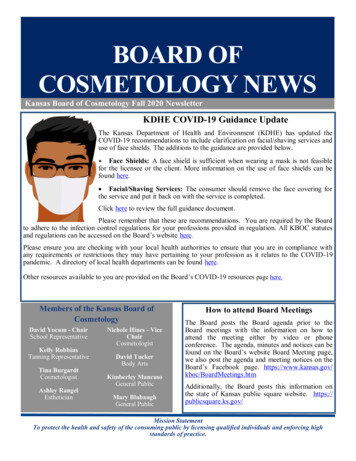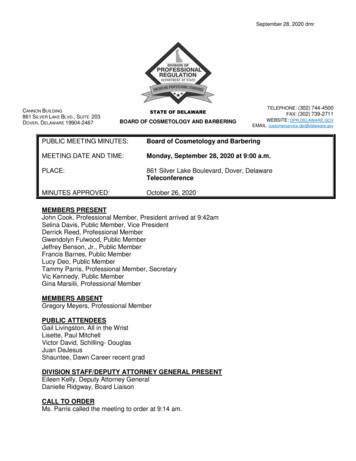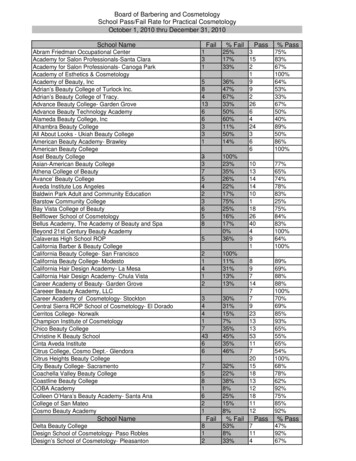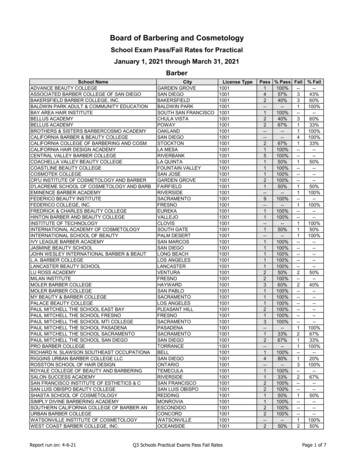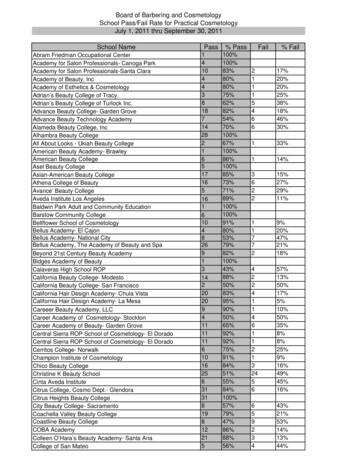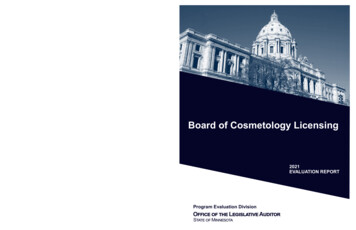
Transcription
Board of Cosmetology Licensing2021EVALUATION REPORTProgram Evaluation DivisionOffice of the Legislative AuditorState of Minnesota
Program Evaluation DivisionEvaluation StaffThe Program Evaluation Division was created withinthe Office of the Legislative Auditor (OLA) in 1975.The division’s mission, as set forth in law, is todetermine the degree to which state agencies andprograms are accomplishing their goals andobjectives and utilizing resources efficiently.James Nobles, Legislative AuditorJudy Randall, Deputy Legislative AuditorTopics for evaluations are approved by theLegislative Audit Commission (LAC), which hasequal representation from the House and Senate andthe two major political parties. However, evaluationsby the office are independently researched by theLegislative Auditor’s professional staff, and reportsare issued without prior review by the commission orany other legislators. Findings, conclusions, andrecommendations do not necessarily reflect the viewsof the LAC or any of its members.OLA also has a Financial Audit Division thatannually audits the financial statements of the Stateof Minnesota and, on a rotating schedule, audits stateagencies and various other entities. Financial auditsof local units of government are the responsibility ofthe State Auditor, an elected office established in theMinnesota Constitution.OLA also conducts special reviews in response toallegations and other concerns brought to theattention of the Legislative Auditor. The LegislativeAuditor conducts a preliminary assessment inresponse to each request for a special review anddecides what additional action will be taken by OLA.Caitlin BadgerEleanor BerrySarah DelacuevaScott FuscoWill HarrisonJody HauerDonald HirasunaDavid KirchnerLucas LockhartIvy MarsnikRyan MoltzJodi Munson RodríguezKaitlyn SchmaltzLaura SchwartzKatherine TheisenCaitlin ZanoniTo obtain reports in electronic ASCII text, Braille,large print, or audio, call 651-296-4708. People withhearing or speech disabilities may call throughMinnesota Relay by dialing 7-1-1 or 1-800-627-3529.To offer comments about our work or suggest anaudit, investigation, or evaluation, call 651-296-4708or e-mail legislative.auditor@state.mn.us.Printed on Recycled PaperFor more information about OLA and to access itsreports, go to: www.auditor.leg.state.mn.us.Photo provided by the Minnesota Department of Administration with recolorization done by 5811929076/in/album-72157663671520964/)Creative Commons License: ode
OL AOFFICE OF THE LEGISLATIVE AUDITORSTATE OF MINNESOTA James Nobles, Legislative AuditorMay 2021Members of the Legislative Audit Commission:The Board of Cosmetology licenses cosmetology practitioners, salons, and schools to protectpublic health and safety.In this evaluation, we found that certain aspects of Minnesota’s complex cosmetology licensingstructure and requirements do not contribute to public health or safety, but do make licensingmore expensive and burdensome for licensees. We recommend a number of changes to thestructure and requirements.Our evaluation was conducted by Laura Schwartz (project manager), Ryan Moltz, andKaitlyn Schmaltz. The Board of Cosmetology and the Board of Barber Examiners cooperatedfully with our evaluation, and we thank them for their assistance.Sincerely,James NoblesLegislative AuditorJudy RandallDeputy Legislative AuditorRoom 140 Centennial Building, 658 Cedar Street, St. Paul, Minnesota 55155-1603 Phone: 651-296-4708 Fax: 651-296-4712E-mail: legislative.auditor@state.mn.us Website: www.auditor.leg.state.mn.us Minnesota Relay: 1-800-627-3529 or 7-1-1
SummaryBoard of Cosmetology LicensingKey Facts and Findings: The Board of Cosmetologist Examiners(“BCE” or “Board of Cosmetology”)regulates cosmetology in Minnesota,which includes services in three broadareas—hair, skin, and nails. (p. 1) To protect public health and safety, statelaw requires cosmetology practitioners tobe licensed. In 2020, BCE oversawaround 32,900 licensed practitioners and5,350 licensed establishments. (p. 4) Certain aspects of Minnesota’s complexlicensing structure do not contribute tothe protection of public health or safety.They do, however, make licensing moreexpensive and burdensome for licensees.(pp. 17-36) State law authorizes BCE to offerspecialty licenses for practitioners whoperform only cosmetic skin or nailservices, but not for those who performonly cosmetic hair services. (pp. 25-27) BCE began issuing just one type of salonlicense in 2018, even though statutesrequire it to issue licenses that aredifferentiated according to the servicesoffered in the salon. (pp. 29-30) BCE offers two types of permits thatallow practitioners to perform servicesoutside of a licensed salon. Although thescope of services that practitioners mayoffer under one of those permits is muchbroader than the other, the requirementsare less stringent. (pp. 31, 35-36) In 2020, the Legislature authorizedpractitioners to perform makeup andhairstyling services without a license orpermit if they take a one-time, four-hourcourse; BCE has no mechanism toenforce this requirement. (pp. 32-33) Most licensees reported satisfaction withBCE’s license application processes, butsome had difficulty getting clear answersto their questions. (pp. 42-46) Even though cosmetology practitionersmay perform all, or nearly all, of thesame services as barbers, the state usestwo different boards to regulate theseoccupations. This has resulted inregulatory inconsistencies and may notbe the most efficient use of stateresources. (pp. 53-63)Key Recommendations: The Legislature should simplifyMinnesota’s licensing structure forpractitioners and modify certain licensingrequirements. (pp. 19-20, 24-25, 36) The Legislature should authorize aspecialty license for practitioners whowish to perform only hair services.(pp. 27-28) The Legislature should allow BCE to issuejust one type of salon license, since thehealth and safety requirements for allsalons are now the same. (p. 30) The Legislature should requireunlicensed practitioners who performmakeup and hairstyling to register withBCE, and BCE should post theregistrations on its website. (pp. 34-35) The Legislature should clarify the scopeof practice for cosmetology practitionersand barbers, and consider whether itmakes sense to continue regulating themseparately. (pp. 56-57, 59, 64-66)OFFICE OF THE LEGISLATIVE AUDITOROL ARoom 140 Centennial Bldg.658 Cedar StreetSt. Paul, MN 55155-1603Minnesotaregulatescosmetology toprotect publichealth andsafety, but someof the state’srequirementsmay beunnecessary.MAY .state.mn.usTel: 651-296-4708 Fax: 651-296-4712Minnesota Relay: 1-800-627-3529 or 7-1-1
S-2Board of Cosmetology LicensingReport SummaryThe Board of Cosmetologist Examiners(“BCE” or “Board of Cosmetology”)regulates cosmetology in Minnesota to protectpublic health. The practice of cosmetologyincludes services related to the cosmetic careof hair, skin, and nails. Cosmetology servicesare regulated only when provided in exchangefor compensation.State law requires cosmetology practitionersto be licensed. In most cases, practitionersmay provide services only in licensedestablishments. In 2020, BCE oversawaround 32,900 licensed practitioners and5,350 licensed establishments (including5,312 salons and 38 singstructure, somepractitionersandestablishmentsmust holdnumerouslicenses.The board is composed of six licensedcosmetology practitioners and one publicmember. In Fiscal Year 2020, BCE had31 employees who were responsible forissuing licenses, inspecting cosmetologyestablishments, and taking enforcementactions. This evaluation focused on BCE’slicensing structure, requirements, andprocesses.Certain aspects of Minnesota’scomplex licensing structure do notcontribute to the protection of publichealth, but do create unnecessaryburdens for licensees.Minnesota’s licensing structure forcosmetology practitioners is organized alongtwo dimensions—level and area of practice.Practitioners may hold licenses at one or moreof the following levels: operator, salonmanager, instructor, and school manager.Practitioners may also hold licenses in variousareas of practice. For example, “estheticians”provide cosmetic skin services; “nailtechnicians” provide cosmetic nail services;and “cosmetologists” provide cosmetic skin,nail, and hair services.Changes in law over time have reduced thevalue of the salon manager level within thelicensing structure. For example, apractitioner no longer needs 2,700 hours ofrecent work experience to obtain the license.As a result, the Legislature should considereliminating the salon manager license.Even though the requirements for aninstructor and a school manager licenseexceed most of the requirements for anoperator or salon manager license, state lawrequires practitioners to maintain one ofthese latter licenses along with theirinstructor or school manager license(s).The Legislature should allow instructor andschool manager licenses to supersedeunderlying operator or salon managerlicenses so practitioners do not need tomaintain multiple levels of licensure.The licensing structure offers specialtylicenses for practitioners who perform onlyskin or nail services, but not those whoperform only hair services. The Legislatureshould create another specialty license sopractitioners who wish to provide onlyhair-related services may be trained morequickly and at less cost. It could alsoconsider creating other narrow-scopespecialty licenses, such as for waxing.The board currently issues just onetype of salon license, even thoughstatutes require it to issue licenses thatare differentiated according to the typeof services offered in the salon.In 2016, BCE updated its rules, makingthe physical and infection-controlrequirements for all types of salons thesame. In 2018, BCE began issuing just onetype of salon license instead of separatelicenses for esthetics salons, nail salons, andcosmetology salons.However, despite the rule change, statutes stillrequire BCE to issue salon licenses that aredifferentiated by area of practice. Given thealignment of salon requirements in rules, theLegislature should modify statutes to allowBCE to issue just one type of salon license.State law allows practitioners toprovide regulated cosmetologyservices outside of licensed salonsunder certain conditions. Some ofthese conditions are incongruous orunenforceable.BCE issues a special event services permitthat allows licensed practitioners to provide avery narrow set of regulated services outside
Summaryof a licensed salon (hairstyling and makeupand nail polish application only). It alsoissues a homebound services permit thatallows licensed practitioners to provide everytype of regulated cosmetology service in thehomes of persons who are homebound.Even though the scope of the special eventservices permit is far narrower, therequirements for it are more stringent thanthose for the homebound services permit.The Legislature and BCE should considerwhether allowing practitioners to performevery type of regulated service under apermit—as is the case with the homeboundservices permit—adequately protects publichealth and safety. The Legislature shouldalso consider merging the two permits into asingle off-premises permit and establishingrequirements that align with the servicesauthorized under the new permit.In 2020, the Legislature began allowingpractitioners to provide regulated makeupand hairstyling services outside of a licensedsalon without a license or permit if they takea four-hour course on health, safety,infection control, and state cosmetologylaws. BCE has no effective means toenforce this requirement. The Legislatureshould require practitioners who have takenthe course to register with BCE, and BCEshould audit a sample of those registrations.BCE should also post those registrations onits website so members of the public knowwho is qualified to perform such services.Most licensees reported generalsatisfaction with the board’s licenseapplication processes, but some haddifficulty getting answers to questions.We surveyed and spoke with licensees abouttheir experiences with BCE’s licensingprocesses. The majority of respondentsreported satisfaction with BCE’s applicationprocesses, website, and communication.Representatives from schools, which aresubject to more extensive applicationprocesses, were less satisfied with BCE’sapplication processes.In addition, some licensees reporteddifficulty getting answers to their questions,such as whether certain services fall withinS-3the scope of practice of their licenses. BCEleadership said staff have been advised notto answer such questions, as their responsescould be perceived as offering legal adviceor conducting unauthorized rulemaking.The U.S. has no national standards forcosmetology licensure; as a result,requirements vary across states, whichcan pose challenges for practitionerswho wish to transfer their licenses.In the absence of national standards, wecompared Minnesota’s licensing requirementsto those of other states. AlthoughMinnesota’s licensing standards werecomparable to national averages and those ofneighboring states in 2017, they were notidentical. For example, both Iowa and SouthDakota required 2,100 hours of training for acosmetologist license, compared toMinnesota’s 1,550 hours.Such differences can make it challenging forpractitioners to transfer their licenses acrossstates. For example, to transfer their licenseto Minnesota, a practitioner with fewer thanthree years of experience and fewer hours oftraining than required by Minnesota lawwould need to enroll in a Minnesotacosmetology school to make up those hoursand pass a practical skills test.The Legislature could authorize BCE toenter into an interstate compact in whichMinnesota accepts licenses from states withsimilar, but not identical, requirements.Such a compact could make it easier forpractitioners to transfer their licenses and forBCE to process transfer applications, whilestill protecting public health and safety.State law provides a special process forveterans and military family members totransfer their cosmetology licenses toMinnesota. But, these practitioners aresubject to some more stringent requirementsthan are other practitioners who wish totransfer their licenses to Minnesota. TheLegislature and BCE should modify therequirements for these practitioners to makethe process more equitable for them.The scope andrequirements forthe board’spermits needfurther review.
S-4Board of Cosmetology LicensingCosmetology practitioners mayperform all, or nearly all, of theservices that barbers may perform, butMinnesota uses two different agenciesto regulate these occupations.Barbering and cosmetology regulation havelong histories in the state, with historicalrestrictions on which genders the twooccupations could serve. Lawsuits andchanges to law have effectively eliminatedthose differences.Confusionexists about thedifferencesbetween theservices thatcosmetologistsand barbers mayperform.Today, both cosmetologists and barbers maycolor, bleach, wave, straighten, and cut hair.Some regulators and practitioners believe thatonly barbers may shave beards, and that onlycosmetology practitioners may performwaxing. But these distinctions are notsupported by current law. If the Legislatureintended for these services to be solely withinthe scope of one occupation or the other, thenit should clarify its intentions in law.Despite significant overlap in their training,state law does not offer any reciprocitybetween cosmetology credentials (which areissued by BCE) and barbering credentials(which are issued by the Board of BarberExaminers). This means that, for example,a cosmetology practitioner would need tocomplete all of the requirements for a barberto become a barber, and vice versa, eventhough both receive training in subjects suchas anatomy, dermatology, chemistry, andinfection control.Because cosmetology and barbering havebeen regulated by two different agenciesfor most of their histories, inconsistentrequirements and regulatory practices haveemerged across these two highly relatedoccupations. For example, under certaincircumstances, cosmetology practitionersmay provide services for a fee outside of alicensed establishment; barbers may not.Cosmetology practitioners must regularlycomplete continuing education; barbers arenot subject to similar requirements.Given the significant overlap betweencosmetology and barbering, we question therationale for using two separate agencies toregulate these occupations. In 2003, theLegislature merged the cosmetology andbarber boards; but, it separated them onlyfive years later amid tensions. The Legislaturecould consider merging the boards again toincrease regulatory consistency across twosuch similar occupations, and to facilitate anefficient use of state resources. It could alsoclarify the scopes of practice for the twooccupations and/or offer license reciprocitybetween them.Summary of Agencies' ResponsesIn a letter dated May 19, 2021, the Board of Cosmetology’s Board Chair and Executive Directorstated that the board is open to changes that OLA recommends to the licensing structure. In the letter,they said the board recommends that the Legislature establish an advisory committee to facilitate thedevelopment of such changes. They also said the board supports OLA’s recommendation that theLegislature allow it to issue just one type of salon license. Additionally, in a letter dated May 20,2021, the Board of Barber Examiners’ Executive Director stated that he and the Board Chair supportOLA’s recommendation that the Legislature allow reciprocity between cosmetology and barberingcredentials and clarify the scopes of practice for cosmetologists and barbers. In addition, in theirletters, representatives from both the cosmetology and barbering boards said they do not supportmerging the boards.The full evaluation report, Board of Cosmetology Licensing, is available at 651-296-4708 y.htm
Table of Contents1Introduction3Chapter 1: Background349Regulatory PurposeGovernanceHistory and Scope of Cosmetology Regulation in Minnesota13Chapter 2: License Structure and Requirements132831Practitioner LicensesEstablishment LicensesPractice Outside of Salons37Chapter 3: Application Processes3742Application Requirements and ProcessingApplicant Experiences53Chapter 4: Cosmetology and Barbering5360Scope of PracticeRegulation and Governance67List of Recommendations69Agencies’ Responses
List of ExhibitsChapter 1: Background8101.1 The Board of Cosmetology’s expenditures jumped significantly between fiscalyears 2016 and 2017.1.2 Minnesota has regulated hair and skin services since 1897.Chapter 2: License Structure and Requirements15162225292.1 Practitioners may be licensed in general cosmetology, or in one or morespecialty area(s).2.2 Statutes and rules establish key licensing requirements for cosmetologypractitioners.2.3 Continuing education requirements vary across license levels.2.4 Minnesota’s licensing structure for cosmetology practitioners could be simpler.2.5 Statutes and rules set key licensing requirements for cosmetologyestablishments.Chapter 3: Application Processes404041513.1 The Board of Cosmetology issued more than 12,000 credentials each fiscalyear between 2012 and 2020.3.2 The Legislature increased license fees in 2015.3.3 The license fee receipts collected by the Board of Cosmetology increasedsignificantly between fiscal years 2015 and 2016.3.4 The cost to obtain and maintain a license may be a barrier for someprospective and current practitioners.Chapter 4: Cosmetology and Barbering58614.1 State law allows practitioners to credit some of the hours of training theyreceived for an initial credential toward some,
(“BCE” or “Board of Cosmetology”) regulates cosmetology in Minnesota, which includes services in three broad areas—hair, skin, and nails. (p. 1) To protect public health and safety, state law requires cosmetology practitioners to be licensed. In 2020, BCE oversaw around 32,900 licensed practitioners and 5,350 licensed establishments. (p.
